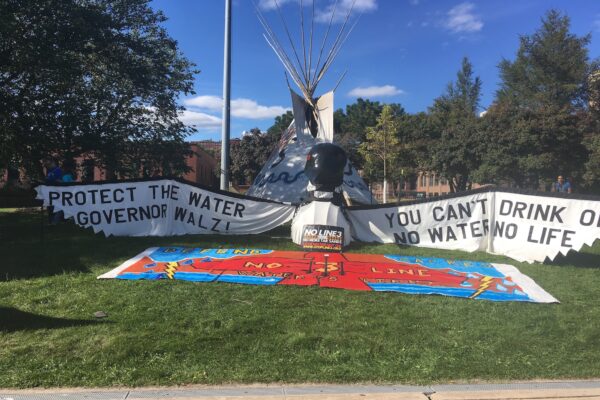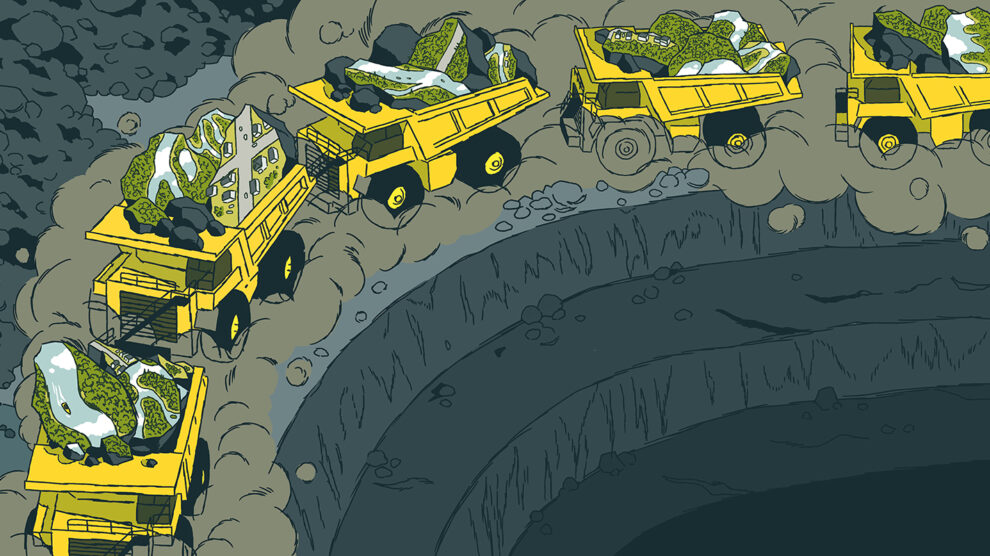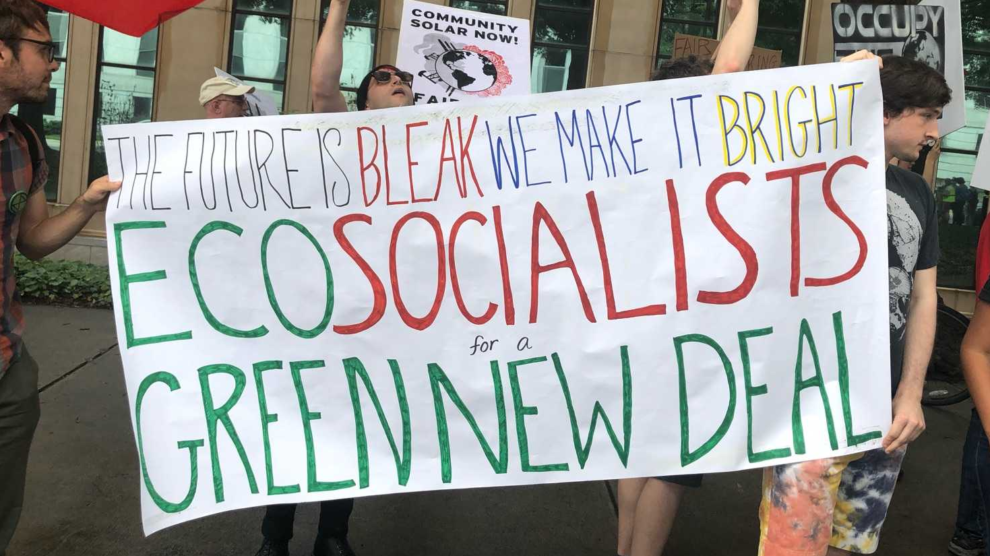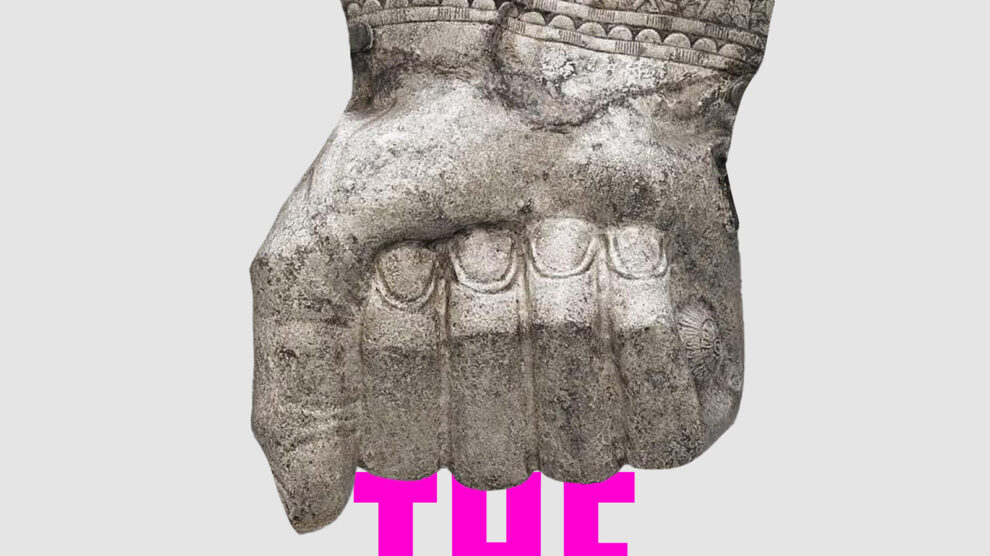Indigenous Knowledge, the Struggle for Land, and Indigenizing the Green New Deal
An Interview with Dina Gilio-Whitaker
By Ragina Johnson and Brian Ward
Volume 23, number 2, People’s Green New Deal

Encuentre una traducción de este artículo en español en nuestro sitio web.
The centrality of Indigenous self-determination is finally making inroads into the climate justice movement. The 2010s brought Native struggle back into the mainstream—from the Idle No More movement in Canada, to Standing Rock against the Dakota Access Pipeline, to the struggle of the Wetʼsuwetʼen Nation in northern British Columbia.1 Itʼs illuminating that US Representative Alexandria Ocasio-Cortez, who introduced the Green New Deal in Congress, was herself transformed by her experience at Standing Rock.2
The history of Indigenous struggle in opposing the plundering of Earthʼs natural resources suggests that the fight for Indigenous sovereignty should be complementary with climate action; yet, there has been a rocky relationship between the environmental and Indigenous movements.
In this interview, conducted November 22, 2019, activists Ragina Johnson and Brian Ward continue a discussion with Dina Gilio-Whitaker that began in Science for the Peopleʼs “Science Under Occupation” issue (Volume 23, no. 1, spring 2020) about the value of Indigenous knowledge in our movement and how we can Indigenize the Green New Deal. Dina Gilio-Whitaker (Colville Confederated Tribes) is the author of As Long As the Grass Grows: The Indigenous Fight for Environmental Justice, From Colonization to Standing Rock, and works as a lecturer, independent consultant, and educator.
Ragina Johnson and Brian Ward: How do you explain Indigenous knowledge to people unfamiliar with the topic?
Dina Gilio-Whitaker: Indigenous knowledge is a really broad term. It refers to how Indigenous people live in the world, but we can break that down into what we call Traditional Ecological Knowledge (TEK). Indigenous knowledge is an Indigenous worldview that is holistic; everythingʼs connected. Itʼs not compartmentalized knowledge. But when weʼre talking specifically about environmental issues, then we can use this term TEK, in terms of the way Indigenous peoples have managed their lands for thousands and thousands of years. Itʼs often called Native science. Gregory Cajete coined that phrase in his book entitled Native Science, published in 2000.3 Native science doesnʼt really differ much from Western science, because the word “science” itself, in Greek, simply means knowledge.
Western science is the pursuit of knowledge, just like Native science is also the pursuit of knowledge, and they use very similar tactics and methodologies, which are really based on observation.
So thereʼs really not as big of a difference between the two paradigms. But with Western science, itʼs very reductionist. Itʼs very concerned with mathematical equations, experimentation, replicability, and quantification.
Native science is not concerned with those kinds of particularities. Itʼs more concerned with what you know about the world based on your experience over long periods of time. Native science also includes observation across the entire realm of the world that Natives inhabit, including [the sky].
Understanding astronomy is important, because looking at the stars and the cycles of the constellations throughout the year provides good signals about when to plant your crops. Native people knew and understood the cycles of the world, the planet, and the seasons because these kinds of observations accumulated for a very, very long period of time. Their relationship with the land was so intimate that they knew the natural world needed tending.
RJ and BW: How does the landscape today look different than it did two or three hundred years ago?
DGW: When Europeans came into these places, they wrote about the way the landscape looked. Yosemite is a perfect example of this. Non-Native people didnʼt come into Yosemite Valley until 1851. When [settlers] came into the valley, they recorded what they saw and talked about the land looking like an orchard: a really well tended garden.4
Everywhere in California was tended by Native peoples who we could consider wild land horticulturists. Itʼs not agriculture in the way that we typically think of agriculture, but it is agriculture because itʼs about managing landscapes to maximize food production as well as cultural materials for things like baskets and clothing. This encouraged the healthy production of plant populations through different means and techniques, which included pruning and seed dispersal and coppicing (which is a radical kind of pruning), and burning.
Whatʼs really astounding is that when the Spanish first came to California, they wrote about how there were times of the year when fires were burning everywhere.5 The Spanish knew that the Indians were lighting these fires intentionally, but they didnʼt understand why. They just chalked it up to all these crazy Indians. They had things wrong because white (settler) supremacy infiltrates everything. White supremacy is all about the inferiorization of Native people and Native knowledge.
Weʼre hearing now that these radical fires in California are due to climate change. Well, itʼs really not due to climate change. Itʼs primarily due to a century of mismanaging forests. This leads to conditions that climate change exacerbates. You have all this underbrush thatʼs drying out because of climate change, but which provides the fuel for these massive fires. Had the forests not been mismanaged for over a century, then we wouldnʼt have the conditions that lead to these extreme fires. Weʼd still have drying, but not the ground brush that fuels these fires.
Now Indigenous peoples are highlighting this knowledge at the highest academic levels. And we have non-Native scientific scholars experimenting and finding out that when you allow the forest to burn, it actually leads to greater water retention. And who would have thought that? It was the Indigenous people who had this practice. It makes sense that when you thin the plant population out, itʼs less competition for water, which allows water to accumulate. Itʼs pretty simple.
RJ and BW: As we see the growing popularity of massive proposals such as the Green New Deal and the Red Deal, introduced by The Red Nation, we have to take the issue of giving land back to Indigenous people seriously.6 How should returning Indigenous land, upholding Indigenous sovereignty, protecting sacred sites, treaties, and the question of consent relate to solutions and next steps for our movements?
DGW: My thought is that there are different ways to return land. Land trusts, conservancies, and shared governance are ways to do it.
You need to have both a pathway and an understanding of how returning land can happen and what are some of the complications. In some cases itʼs less complicated than others.
One example: thirty two thousand acres were recently given back to some tribes in Oregon.7 These were public lands that the Bureau of Land Management turned over to tribes who can then put them into trust.8 Thatʼs a little less complicated than California.
Another example is the Ballona Wetlands in Los Angeles. All of coastal southern California used to be a massive network of wetlands, and this connected the Tongva, the Acjachemen, the Kumeyaay, and Luiseños. The landscape has been reengineered until almost none of the wetlands are left now. Thereʼs been a long standing fight to preserve this last patch.
The wetlands are under both private and public ownership with 600 acres protected.9 Itʼs a very complex tangle of stakeholders, but there are no partnerships with the Tongva. They are represented in a public exhibit (an outdoor museum called Discovery Park), but they are not represented in any governance structures. They are also not a federally recognized tribe, and there are different competing factions. They have some recognition, but in California thereʼs no such thing as “state-recognized tribes” as in other states.
In a case like this, who do you give the land back to? Because there are factions and thereʼs no legal tribal entity, the land canʼt be put in a federal trust as reservation land. In this settler system, thereʼs got to be some kind of legal mechanism connecting the Tongva to the land.
You can talk about different ways to do that, different legal formations, so it becomes a matter of governance. Itʼs not as simple as giving the land back. In many cases it just may not be possible because of the complications of history and development. But that doesnʼt mean that Indigenous people canʼt be given authority and decision-making power in their ancestral lands. I think thatʼs the goal. How do you restore Indigenous authority to their ancestral places? By considering all kinds of possibilities and alternative land arrangements, including shared governance.
RJ and BW: Exactly, it looks very different in California than it does in South Dakota or Wisconsin. For instance, the Menominee were terminated during the 1950s, but they fought back and got their reservation restored.10 Now, they manage their forests in such an ecologically sound way that you can see the outline of their reservation from space.11
It seems what youʼre saying is that there is a difference between political slogans and what we actually have to do. Our movement has to understand all of this if weʼre able to fight for real policy reforms, including: Indigenizing the Green New Deal. If you think about stopping extraction in California or the question of expanding public transportation, the question of Indigenous sovereignty, treaty rights, and consent has to be at the forefront.
This reminds us of what you write about in your book regarding the history of the climate justice movement and the idea of “multiculturalism.” Just saying, “the Green New Deal needs to take up environmental racism,” doesnʼt actually talk about the question of Indigenous rights, historical wrong, and solutions.
DGW: Right, and thatʼs my focus and the work that I do. We have to talk about policy and specifics as we look at the big picture of Indigenous liberation, because ultimately we have to engage with the hegemonic powers. Thereʼs no getting around that. Plus, how are you going to implement all these great ideas without tribal governments?
It begins with settler institutions (including science-based institutions) engaging Indigenous people in all their conversations, and the recognition of cultural and political sovereignty. Itʼs a simple matter of respect. And given that we have some tangible knowledge about how to effectively manage lands, draw on that. Just stop bypassing Native people as if we donʼt exist or as if we have nothing of value to contribute.
I call it un-erasing Indigenous people. Of course the erasure is everywhere, but some places are more intense than others. California is one of the places where erasure is the most intense.
So wherever, whatever kind of project that youʼre talking about, you must include Native voices and governments when appropriate. If we start there, then we create patterns of un-erasure and take meaningful steps in accordance with respect to Native people.
A huge part of respect is for settler people who care about the environment to support the concept of free, prior, and informed consent in development that involves Native traditional cultural properties. This is very different than consultation, which is often meaningless.
Everyday development projects uncover Indian burials in California. Think of the gravity of that and the trauma if youʼre Native and itʼs your ancestors being violated. Youʼre watching your ancestors get dug up and youʼve got virtually no legal protection, especially on privately owned lands. In California, thereʼs no kind of development that doesnʼt somehow involve Indigenous concerns. The state [of California] could strengthen protections for traditional cultural properties by embracing consent as part of permitting processes.
On the national level, the Green New Deal is a step in the right direction toward building environmental justice into climate change policy. And as Iʼve written about elsewhere, there are steps that can be taken to “Indigenize” it, thus making it more responsive to Indigenous issues.12 This would include explicit recognition of Indigenous nationhood and political relationships to the US (not based on race), and the affirming of TEK as a methodology for tackling climate change.
The GND is modeled after FDRʼs New Deal, which is always celebrated as progressive action that lifted the US out of economic depression through infrastructure development projects like dams and extractive industries that put people to work. Whatʼs far less acknowledged, however, is how much environmental and cultural death and destruction all that development wreaked on Indian country. We see a similar pattern occurring globally in the realm of “sustainable” development, which has given rise to a modern global land rush that impacts Indigenous communities the most.13 Ultimately, unchecked capitalism is the problem and we need to heed the research that connects cultural diversity with biodiversity if we are to avoid the worst impacts of climate change.14
References
- “Unistʼotʼen: Heal the People, Heal the Land,” 2017, accessed June 26, 2020, http://unistoten.camp/.
- Rebecca Solnit, “Standing Rock Inspired Ocasio-Cortez to Run: Thatʼs the Power of Protest,” The Guardian, January 14, 2019, https://www.theguardian.com/commentisfree/2019/jan/14/standing-rock-ocasio-cortez-protest-climate-activism.
- Michael Wassegijig Price, “Native Science: Natural Laws of Interdependence,” Tribal College: Journal of American Indian Higher Education, May 15, 2001, https://tribalcollegejournal.org/native-science-natural-laws-interdependence/.
- M. Kat Anderson, Tending the Wild: Native American Knowledge and the Management of Californiaʼs Natural Resources, (Los Angeles: University of California Press, 2005).
- Anderson, Tending the Wild. See also the documentary show based on the book, Tending the Wild, E1: “Cultural Burning: How Native American Peoples Use Fire to Rejuvenate the Land,” KCET.org, https://www.kcet.org/shows/tending-the-wild.
- “A Red Deal: Indigenous Action to Save the Earth,” The Red Nation, September 21, 2019, https://therednationdotorg.files.wordpress.com/2019/09/a-red-deal_-full-working-draft_9-21-19-1.pdf.
- Anna V. Smith, “When Public Lands become Tribal Lands Again,” High Country News, August 16, 2019, https://www.hcn.org/issues/51.15/tribal-affairs-when-federal-lands-become-tribal-lands-again-public-lands.
- “The Origins of our Trust Responsibility Towards the Tribes,” Friends Committee on National Legislation, September 29, 2010, https://www.fcnl.org/updates/the-origins-of-our-trust-responsibility-towards-the-tribes-132.
- “Our History,” Friends of Ballona Wetlands, 2019, accessed June 26, 2020, https://www.ballonafriends.org/our-history.
- “Menominee Termination and Restoration,” Milwaukee Public Museum, 2019, accessed June 26, 2020, https://www.mpm.edu/content/wirp/ICW-97.
- Doris Karambu Onesmus, “Sustainable Management of Forest by Menominee Tribe from Past to Present,” University of Wisconsin-Stevens Point, Student Journal: Native American Forestry, 2008, https://www.uwsp.edu/forestry/StuJournals/Documents/NA/donesmus.pdf.
- Dina Gilio-Whitaker, “How to Indigenize the Green New Deal and Environmental Justice,” High Country Times, July 10, 2019, https://www.hcn.org/articles/tribal-affairs-how-to-indigenize-the-green-new-deal-and-environmental-justice.
- Smita Narula, “The Global Land Rush: Markets, Rights, and the Politics of Food,” Stanford Journal of International Law 49, no. 1 (July 2013): 101, https://papers.ssrn.com/sol3/papers.cfm?abstract_id=2294521.
- The United Nations has long recognized the links between cultural and biodiversity relative to sustainable development. See, for instance, UNESCOʼs Biodiversity Initiative, particularly its Local and Indigenous Knowledge Systems Programme; http://www.unesco.org/new/en/natural-sciences/priority-areas/links/.





